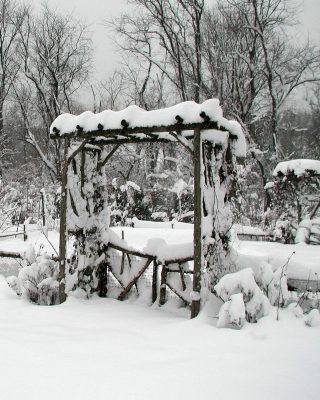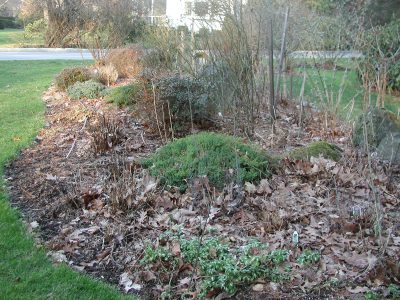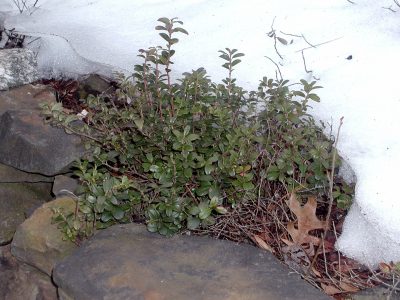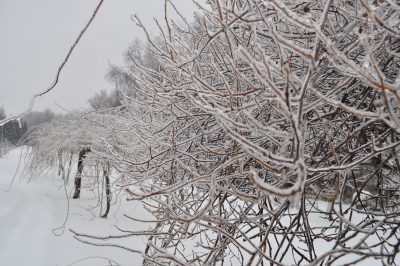Cold Rules
Water Freezes. Why Don’t Plants?
(The following is adapted from my book, The Ever Curious Gardener: Using a Little Natural Science for a Much Better Garden, available wherever fine books are sold, and my website.)
Not being able to don gloves and a scarf, or shiver, to keep warm, it’s a wonder that trees and shrubs don’t freeze to death from winter cold. They can’t stomp their limbs or do jumping jacks to get their sap moving and warm up. The sap has no warmth anyway.
Sometimes, of course, plants do succumb to winter cold. But usually that happens to garden and landscape plants pushed to their cold limits, not to native plants in their natural habitats or to well adapted exotic plants.
Think about it: water freezes at 32 degrees Fahrenheit—not a particularly cold temperature for a winter night—and plants contain an abundance of water. Water is unique among liquids in that it expands when it freezes, so you can imagine the havoc that could be wreaked as water-filled plant cells freeze and burst. Yet plants that must stand tall all winter do, of course, deal with frigid weather.
A Helping Hand for Herbaceous Plants
Herbaceous perennials (non-woody plants) opt for the easiest survival route.Their roots are perennial but their tops die back to the ground each year. Anticipate cold weather, these plants start pumping reserve nutrients to their roots in late summer. That’s why asparagus, cone flowers, delphiniums, and peonies are reduced, in autumn, to nothing more than a few dry stalks. 
What’s left of these plants spends a mild winter underground. Five feet down, the earth’s temperature hovers around a relatively balmy 50 degrees Fahrenheit.
Practical Rule #1: A thick blanket of some fluffy, organic material—leaves, straw, or wood chips, for example—further limits cold penetration.
Also for Woody Creepers
Low-growing, woody plants have it almost as good, with their stems shielded from the full brunt of cold winter winds. If Nature decides to throw down a powdery, white insulating blanket, so much the better: those leaves and low stems are protected even more. 
Practical Rule #2: In case Mother Nature is distracted with other activities, I provide my own low blanket for low-growing, woody or evergreen perennials—again, that fluffy cover of straw, leaves, or wood chips. Waiting to cover these plants until the weather turns relatively cold (soil frozen an inch deep is a good rule of thumb) lets plants acclimate to cold, and their stems and leaves have no chance of rotting beneath mulch that is still moist and too warm.
Tricks and Tips for Trees and Large Shrubs
What about trees and shrubs whose stems are fully exposed. One way they protect themselves from freezing is by shedding those parts most likely to freeze—their leaves.
Which introduces Practical Rule #3: I help plants along with their leaf shedding by letting plants naturally slow down and begin to reallocate their energy resources beginning in late summer. No water, fertilizer, or pruning at that time.
Of course, their stems still have to stand up and face the cold. Their living cells are filled with water. If this water freezes, the cells either dehydrate or suffer physical damage from ice crystals.
Water, whether in a plant cell or a glass, does not necessarily freeze as soon as the temperature drops below 32 degrees Fahrenheit. To freeze, water molecules need something to group around to form ice crystals, a so-called nucleating agent. Otherwise it “supercools,” remaining liquid down to about minus 40 degrees Fahrenheit, at which point ice forms whether or not a nucleating agent is present.
All sorts of things can serve as nucleating agents—bacteria, for instance—so plants may not be protected all the way down to minus 40 degrees Fahrenheit by having their water supercool. But winter temperatures don’t plummet that low everywhere, so just a bit of supercooling may be all a plant needs to survive winter cold.
Another trick, effective well below that minimum supercooling temperature, is for a plant to gradually move water out of its cells into spaces between the cells. As temperatures drop, ice crystals outside plant cells grow with the water they draw out of the cells; plants then are threatened by dehydration than by freezing. Plants toughest to cold are those that are best at reabsorbing the water outside their cells when temperatures warm. 
One other mechanism at work “freezing point depression,” which is why antifreeze keeps the water in your car radiator from freezing. Dissolving anything in water lowers the freezing point, more so the more that’s dissolved. As liquid in plant cells lose water, remaining water becomes more and more concentrated in sugars and minerals, its freezing point keeps falling.
Plants actively prepare for cold, with cell walls increasingly strong and and permeable. Light supplies needed energy for all this, making Practical Rule #4 to make sure to site and prune plants for adequate light.
Unfortunately, all this fiddling with a plant to help it through winter palls in the face of genetics. The very most that I can do to help plants face winter is to plant those that naturally tolerate the coldest temperatures winter is apt to serve up.


You make learning easy, and that’s a rare gift and thank you!
Thank you (blushing).
What a tremendously timely and helpful post, Lee. Thanks! What are the chances that the plants and trees subjected to minus 50 in the Midwest due to the Arctic vortex will suffer damage, and is likely to be from dehydration or what?
Survival depends on the plant’s genetics, the depth and duration of cold, and probably a number of other things (wind, humidity, state of plant going into cold weather). Mechanism of damage also will depend on a number things.Sorry to be so vague. That minus 50 is with wind chill, right?
The temp in Chicago was below 20 this week. On Friday the temp will climb back to near 40s. What effect will the drastic weather change have on tall bushes (peony trees, red dogwood bushes & wigela shrubs)? Appreciate that you don’t dumb-down your explanations and really found your facts about nucleating agents fascinating. Thank you. JT
Dogwood should be fine. Tree peony and perhaps wiegela probably not so happy. It’s hard to make definite predictions because so many things affect hardiness. But, as I’ve said, genetics is the most important determinant.
Where does garlic fall in these categories, Lee? I tried completely burying garlic plants in leaves, and they did not do well. This year, I have about 3-4 inches of the same leafy mulch with the tops poking through. Will it survive?
I think, yes, the garlic will be fine. The leaves might get burned back but the plants have stored energy to push up new leaves. The growing point for garlic, like other monocotyledenous plants (lilies, daffodils, onions, etc.) stay cozy and warmish beneath he ground. The leafy mulch helps keep them warm. Too much, though, could smother the plants so they use up energy reserves before the leaves reach light. Your plants should be okay. Keep me posted.
Excellent, thanks for the info!